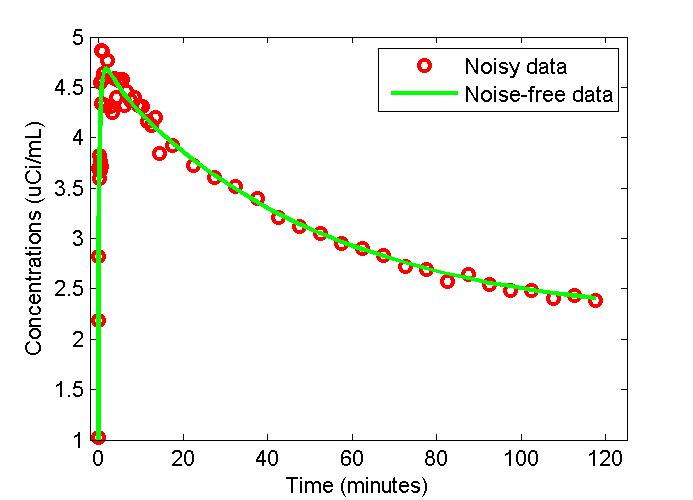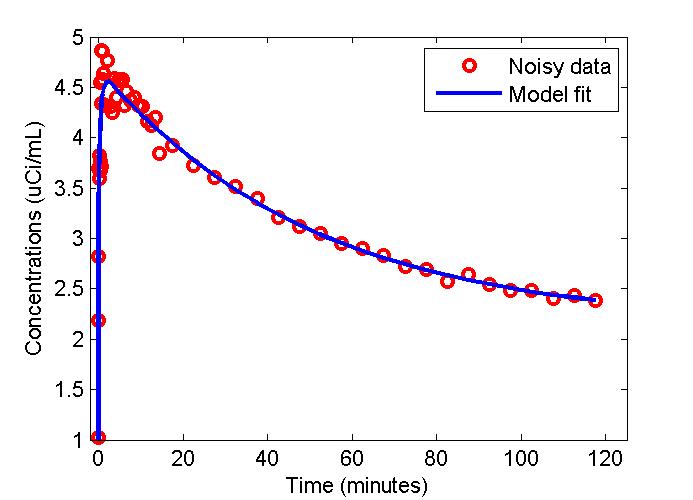Support:Documents:Examples:Estimate physiological parameters using a physiologically based model
Jump to navigation
Jump to search
Estimation of Physiological Parameters Using a Physiologically Based Model
Overview
To evalute glucose trasnport and phosphorylation in skeletal muscle,a physiologically based model has been proposed by our group.
Here, we show an example of implementation of the proposed model using COMKAT.
Example of Implementation of the Physiologically Based Model
cm=compartmentModel;
% Define parameters
cm=addParameter(cm,'k1',0.1);
cm=addParameter(cm,'k2','k1/Fis');
cm=addParameter(cm,'k3','VG/(Fis*KGa+Fis*ISg*KGa/KGg)');
cm=addParameter(cm,'k4','VG/(Fic*KGa+Fic*ICg*KGa/KGg)');
cm=addParameter(cm,'k5','VH/(Fic*KHa+Fic*ICg*KHa/KHg)');
cm=addParameter(cm,'Fb',0.02); % fraction of total space occupied by blood
cm=addParameter(cm,'Fis',0.3); % fraction of total space occupied by interstitial space
cm=addParameter(cm,'Fic','1-Fis-Fb'); % fraction of total space occupied by intracellular space
cm=addParameter(cm,'F',1);
cm=addParameter(cm,'Pg',6); % Plasma glucose concentration (mM)
cm=addParameter(cm,'ISg',5.4); % Interstitial glucose concentration (mM)
cm=addParameter(cm,'ICg',0.2); % Intracellular glucose concentration (mM)
cm=addParameter(cm,'KGg',3.5); % Michaelis constant of glucose transporter (GLUT) for glucose (mM)
cm=addParameter(cm,'KHg',0.13); % Michaelis constant of hexokinase for glucose (mM)
cm=addParameter(cm,'KGa',14); % Michaelis constant of glucose transporter (GLUT) for glucose analog (mM)
cm=addParameter(cm,'KHa',0.17); % Michaelis constant of hexokinase for glucose analog (mM)
cm=addParameter(cm,'VG','(k1*Pg-k1*ISg)/(ISg/(KGg+ISg)-ICg/(KGg+ICg))'); % Maximal velocity of glucose transport for glucose=6FDG=2FDG
cm=addParameter(cm,'VH','(k1*Pg-k1*ISg)/(ICg/(KHg+ICg))'); % Maximal velocity of glucose phosphorylation for glucose=6FDG=2FDG
% Specific activity (sa): if the unit of image data is the same with that of input function, the specific activity is 1.
cm=addParameter(cm,'sa',1);
% Usually, the decay time correction of image data is performed. So, dk is zero.
cm=addParameter(cm,'dk',0);
% Define scan time
delay = 0.0;
scanduration = 120;
t=[ones(5,1)/30;ones(10,1)/12;ones(12,1)*0.5;ones(8,1);ones(21,1)*5];
scant = [[0;cumsum(t(1:(length(t)-1)))] cumsum(t)];
scanTime = [scant(:,1),scant(:,2)];
cm = set(cm, 'ScanTime', scanTime);
lambda = [-12.02 -2.57 -0.02];
a = [1771.5 94.55 14.27];
cm = addParameter(cm, 'pfeng', [delay a lambda]');
cm = addInput(cm, 'Cp', 'sa', 'dk', 'fengInputByPar','pfeng'); % Cp is the plasma input function
cm = addInput(cm, 'Ca',1,0, 'fengInputByPar', 'pfeng'); % Ca is the decay-corrected whole-blood input function. Herein, we assume that Cp=Ca.
% Define compartment
cm=addCompartment(cm,'IS'); % interstitial
cm=addCompartment(cm,'IC'); % intracellular
cm=addCompartment(cm,'IP'); % intracellular phosphorylated
cm=addCompartment(cm,'Junk');
% Define link
cm=addLink(cm,'L','Cp','IS','k1');
cm=addLink(cm,'K','IS','Junk','k2');
cm=addLink(cm,'K','IS','IC','k3');
cm=addLink(cm,'K','IC','IS','k4');
cm=addLink(cm,'K','IC','IP','k5');
% Define output obtained from each normalized compartment
wlistTotal={'IS','F';'IC','F';'IP','F'};
xlistTotal={'Ca','Fb'};
cm=addOutput(cm,'TissueTotal',wlistTotal,xlistTotal);
cm=addSensitivity(cm,'k1','ISg','ICg','Fis','Fb');
[PET,PETIndex,Output,OutputIndex]=solve(cm);
noise_level=0.05;
sd=noise_level*sqrt(PET(:,3)./(PET(:,2)-PET(:,1)));
data=sd.*randn(size(PET(:,3)))+PET(:,3);
cm=set(cm,'ExperimentalData',data);
cm = set(cm,'ExperimentalDataSD',sd);
optsIRLS = setopt('SDModelFunction', @IRLSnoiseModel);
cm = set(cm, 'IRLSOptions', optsIRLS);
oo = optimset('TolFun', 1e-8, 'TolX', 1e-4,'Algorithm','interior-point');
cm = set(cm, 'OptimizerOptions', oo);
% Set initial conditions and boundary conditions
% k1, ISg, ICg, Fs, Fv
pinit = [0.01 ; 4.4 ; 0.1 ;0.15 ; 0.01];
plb = [0.001; 1 ; 0.001;0.10 ; 0 ];
pub = [0.5 ; 6 ; 1 ;0.60 ; 0.04];
[pfit, qfit, modelfit, exitflag, output, lambda, grad, hessian, objfunval] = fitGen(cm, pinit, plb, pub, 'IRLS');
figure;
t = 0.5*(PET(:,1)+PET(:,2));
plot(t,PET(:,3),'g-',t,data,'ro','LineWidth',2);
xlabel('Time (minutes)');
ylabel('Concentrations (uCi/mL)');
legend('Noisy data','Noise-free data');
figure;
t = 0.5*(PET(:,1)+PET(:,2));
plot(t,data,'ro',t,modelfit,'b-','LineWidth',2);
xlabel('Time (minutes)');
ylabel('Concentrations (uCi/mL)');
legend('Noisy data', 'Model fit');
Pg=6;KGa=14;KHa=0.17;KGg=3.5;KHg=0.13; % Unit is mM
k1=pfit(1);k2=pfit(1)/pfit(4);ISg=pfit(2);ICg=pfit(3);Fis=pfit(4);Fb=pfit(5);
VG=(k1*ISg-k1*Pg)/(ICg/(KGg+ICg)-ISg/(KGg+ISg))
VH=(k1*Pg-k1*ISg)/(ICg/(KHg+ICg))
CI=VG*ISg/(KGg+ISg)
CE=VG*ICg/(KGg+ICg)
PR=VH*ICg/(KHg+ICg)

